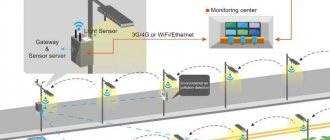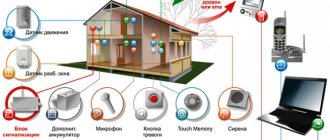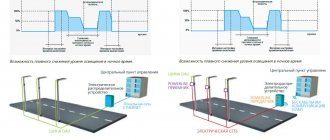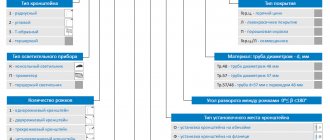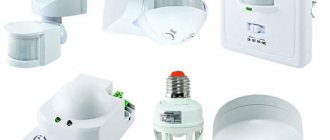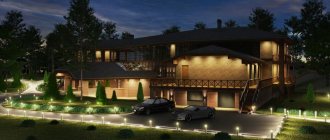External street lighting is carried out in accordance with the requirements established by GOST; today this system is distinguished by its versatility and diversity. Only after studying and comparing the entire range of factors influencing the quality of road lighting should one begin to install street lighting. Highway lighting plays an important role in this matter. These roads have complex and dynamic traffic. And safety on the roadway, the life and health of road users directly depend on how well the road lighting is done. Therefore, strict standards and requirements for the parameters of lighting equipment in populated areas, established by GOST, have been developed and provided for. External lighting is important in principle in populated areas, and in the equipment of highways it plays a major role and is the first necessity in the dark.
In the article you will become familiar with the standards, requirements for important elements of outdoor lighting, and the rules for the selection and installation of lighting devices on the roads of populated areas.
Tables of street and road lighting standards
Roads and streets within the boundaries of settlements
The values are given based on SP 52.13330.2016 “Natural and artificial lighting”.
Road class A1
Main roads and city streets outside the city center, transport and functional axes, exits to external federal highways. Used by all types of transport moving continuously and at high speed. Multi-level intersections and a central dividing strip are used.
| Design speed, km/h | 100 | Number of lanes in both directions | 6 — 8 | Throughput, thousand units/day | Over 10.0 |
Table of lighting standards “Road class A1”
| Average brightness of the road surface Laver, cd/m2, not less | 2,00 |
| General uniformity of road surface brightness U0, not less | 0,40 |
| Longitudinal uniformity of road surface brightness Ui, not less | 0,70 |
| Threshold brightness increment TI, %, no more | 10 |
| Average illumination of the road surface Eср, lux, not less | 30 |
| Uniformity of illumination of the road surface Uh, not less | 0,35 |
| Maximum relative specific power at normalized illumination, Dp, mW*m-2*lx-1, no more | 60 |
Look at the ready-made solution “Class A1 Road Lighting”
Road class A2
Main roads and city streets outside the city center, main transport channels, including those with access to external highways and expressways. Used by all types of transport. Movement is both continuous and controlled. The intersection with highways can be single- or multi-level.
| Design speed, km/h | 80 — 100 | Number of lanes in both directions | 6 — 8 | Throughput, thousand units/day | 7,0 — 9,0 |
Table of lighting standards “Road class A2”
| Average brightness of the road surface Laver, cd/m2, not less | 1,60 |
| General uniformity of road surface brightness U0, not less | 0,40 |
| Longitudinal uniformity of road surface brightness Ui, not less | 0,70 |
| Threshold brightness increment TI, %, no more | 10 |
| Average illumination of the road surface Eср, lux, not less | 20 |
| Uniformity of illumination of the road surface Uh, not less | 0,35 |
| Maximum relative specific power at normalized illumination, Dp, mW*m-2*lx-1, no more | 50 |
Look at the ready-made solution “Class A2 Road Lighting”
Road class A3
Main roads and streets of citywide importance in the central part of the city, transport axes of its historical center, connecting streets with access to highways of classes A1 and A2. Used by all types of transport with the exception of transit freight. The traffic is regulated, the intersections with highways are on the same level, there are numerous pedestrians.
| Design speed, km/h | 90 | Number of lanes in both directions | 6 — 8 | Throughput, thousand units/day | 4,0 — 7,0 |
Table of lighting standards “Road class A3”
| Average brightness of the road surface Laver, cd/m2, not less | 1,40 |
| General uniformity of road surface brightness U0, not less | 0,40 |
| Longitudinal uniformity of road surface brightness Ui, not less | 0,70 |
| Threshold brightness increment TI, %, no more | 12 |
| Average illumination of the road surface Eср, lux, not less | 20 |
| Uniformity of illumination of the road surface Uh, not less | 0,35 |
| Maximum relative specific power at normalized illumination, Dp, mW*m-2*lx-1, no more | 48 |
Look at the ready-made solution “Lighting of Class A3 roads”
Road class A4
Main roads and streets of citywide importance in the central part of the city, its main transport channels. They provide internal connections and have access to main streets of citywide and regional significance. Used by all types of transport with the exception of transit freight. The traffic is regulated, the intersections with highways are on the same level, there are numerous pedestrians.
| Design speed, km/h | 80 | Number of lanes in both directions | 4 — 6 | Throughput, thousand units/day | 3,0 — 5,0 |
Table of lighting standards “Road class A4”
| Average brightness of the road surface Laver, cd/m2, not less | 1,20 |
| General uniformity of road surface brightness U0, not less | 0,40 |
| Longitudinal uniformity of road surface brightness Ui, not less | 0,70 |
| Threshold brightness increment TI, %, no more | 12 |
| Average illumination of the road surface Eср, lux, not less | 20 |
| Uniformity of illumination of the road surface Uh, not less | 0,35 |
| Maximum relative specific power at normalized illumination, Dp, mW*m-2*lx-1, no more | 45 |
Look at the ready-made solution “A4 class road lighting”
Road class B1
Highways and district streets outside the city center. Provide connections within residential areas and industrial areas, as well as between them. Used by all types of transport, traffic is regulated, single-level intersections.
| Design speed, km/h | 60 — 70 | Number of lanes in both directions | 4 — 6 | Throughput, thousand units/day | 3,0 — 5,0 |
Table of lighting standards “Road class B1”
| Average brightness of the road surface Laver, cd/m2, not less | 1,20 |
| General uniformity of road surface brightness U0, not less | 0,40 |
| Longitudinal uniformity of road surface brightness Ui, not less | 0,60 |
| Threshold brightness increment TI, %, no more | 12 |
| Average illumination of the road surface Eср, lux, not less | 20 |
| Uniformity of illumination of the road surface Uh, not less | 0,35 |
| Maximum relative specific power at normalized illumination, Dp, mW*m-2*lx-1, no more | 45 |
Look at the ready-made solution “Class B1 Road Lighting”
Road class B2
Highways and streets of regional significance in the city center, axes of functional and planning zones of the historical part. They provide internal communications and have access to main streets of city and regional significance. Used by all types of transport except transit freight, traffic is regulated, single-level intersections.
| Design speed, km/h | 60 | Number of lanes in both directions | 3 — 6 | Throughput, thousand units/day | 2,0 — 5,0 |
Table of lighting standards “Road class B2”
| Average brightness of the road surface Laver, cd/m2, not less | 1,00 |
| General uniformity of road surface brightness U0, not less | 0,40 |
| Longitudinal uniformity of road surface brightness Ui, not less | 0,60 |
| Threshold brightness increment TI, %, no more | 15 |
| Average illumination of the road surface Eср, lux, not less | 15 |
| Uniformity of illumination of the road surface Uh, not less | 0,35 |
| Maximum relative specific power at normalized illumination, Dp, mW*m-2*lx-1, no more | 53 |
Look at the ready-made solution “Class B2 Road Lighting”
Road class B1
Streets and roads of local importance in residential areas outside the city center, transport and pedestrian connections within areas with access to highways, with the exception of streets with continuous traffic. Passenger, special and cargo transport (except for transit), sometimes public passenger transport. The traffic is regulated, the intersections are one-level.
| Design speed, km/h | 60 | Number of lanes in both directions | 2 — 4 | Throughput, thousand units/day | 1,5 — 3,0 |
Table of lighting standards “Road class B1”
| Average brightness of the road surface Laver, cd/m2, not less | 0,80 |
| General uniformity of road surface brightness U0, not less | 0,40 |
| Longitudinal uniformity of road surface brightness Ui, not less | 0,50 |
| Threshold brightness increment TI, %, no more | 15 |
| Average illumination of the road surface Eср, lux, not less | 15 |
| Uniformity of illumination of the road surface Uh, not less | 0,25 |
| Maximum relative specific power at normalized illumination, Dp, mW*m-2*lx-1, no more | 50 |
Look at the ready-made solution “Class B1 road lighting”
Road class B2
Streets and roads of local importance in residential areas of the city center. They provide transport and pedestrian connections within the microdistricts and have access to the main streets of the center. There are passenger, special and cargo vehicles (with the exception of transit). The movement is regulated with intersections at the same level.
| Design speed, km/h | 60 | Number of lanes in both directions | 2 — 4 | Throughput, thousand units/day | 1,5 — 3,0 |
Table of lighting standards “Road class B2”
| Average brightness of the road surface Laver, cd/m2, not less | 0,60 |
| General uniformity of road surface brightness U0, not less | 0,40 |
| Longitudinal uniformity of road surface brightness Ui, not less | 0,50 |
| Threshold brightness increment TI, %, no more | 15 |
| Average illumination of the road surface Eср, lux, not less | 10 |
| Uniformity of illumination of the road surface Uh, not less | 0,25 |
| Maximum relative specific power at normalized illumination, Dp, mW*m-2*lx-1, no more | 50 |
Look at the ready-made solution “Class B2 road lighting”
Road class B3
Streets and roads of local importance in urban, industrial, municipal and warehouse areas, transport links within these areas. Used by all types of transport. The traffic is regulated, all intersections are one-level.
| Design speed, km/h | 60 | Number of lanes in both directions | 2 — 4 | Throughput, thousand units/day | 0,5 — 2,0 |
Table of lighting standards “Road class B3”
| Average brightness of the road surface Laver, cd/m2, not less | 0,40 |
| General uniformity of road surface brightness U0, not less | 0,35 |
| Longitudinal uniformity of road surface brightness Ui, not less | 0,40 |
| Threshold brightness increment TI, %, no more | 20 |
| Average illumination of the road surface Eср, lux, not less | 6 |
| Uniformity of illumination of the road surface Uh, not less | 0,25 |
| Maximum relative specific power at normalized illumination, Dp, mW*m-2*lx-1, no more | 50 |
Look at the ready-made solution “Class B3 road lighting”
Public roads outside settlements
The values are given based on GOST R 58107.1-2018, the calculated values of throughput, traffic speed and number of lanes are based on SP 34.13330.2012.
Road category IA
Highways designed for the safe and uninterrupted movement of high-intensity traffic flows at high speeds. It is necessary to have a dividing strip or place each direction of movement on a separate road surface. Access for pedestrians and cyclists is prohibited, there are no single-level intersections, and the number of junctions (both single- and two-level) is limited.
| Design speed, km/h | 120 — 150 | Number of lanes in both directions | 4 — 8 | Throughput, thousand units/day | Over 14.0 |
Table of lighting standards “Road category IA”
| Average brightness of the road surface Laver, cd/m2, not less | 1,60 |
| General uniformity of road surface brightness U0, not less | 0,40 |
| Longitudinal uniformity of road surface brightness Ui, not less | 0,70 |
| Threshold brightness increment TI, %, no more | 10 |
| Average illumination of the road surface Eср, lux, not less | 20 |
| Uniformity of illumination of the road surface Uh, not less | 0,35 |
| Peripheral illumination coefficient SR, not less | 0,35 |
| Maximum relative specific power at normalized illumination, Dp, mW*m-2*lx-1, no more | 50 |
Road category IB
This includes roads for high-speed traffic with a mandatory median strip. Same-level intersections are not allowed, and junctions at the same level are allowed only without crossing the direct direction of movement.
| Design speed, km/h | 100 — 120 | Number of lanes in both directions | 4 — 8 | Throughput, thousand units/day | Over 14.0 |
Table of lighting standards “Road category IB”
| Average brightness of the road surface Laver, cd/m2, not less | 1,20 |
| General uniformity of road surface brightness U0, not less | 0,40 |
| Longitudinal uniformity of road surface brightness Ui, not less | 0,70 |
| Threshold brightness increment TI, %, no more | 10 |
| Average illumination of the road surface Eср, lux, not less | 15 |
| Uniformity of illumination of the road surface Uh, not less | 0,35 |
| Peripheral illumination coefficient SR, not less | 0,35 |
| Maximum relative specific power at normalized illumination, Dp, mW*m-2*lx-1, no more | 50 |
Road category IB
Regular roads with medium traffic intensity, accessible to all types of transport. The presence of a median strip is not a mandatory requirement. Bicycle and pedestrian paths must be additionally separated from the main road.
| Design speed, km/h | 80 — 100 | Number of lanes in both directions | 4 — 8 | Throughput, thousand units/day | Less than 14.0 |
Table of lighting standards “Road category IB”
| Average brightness of the road surface Laver, cd/m2, not less | 1,00 |
| General uniformity of road surface brightness U0, not less | 0,40 |
| Longitudinal uniformity of road surface brightness Ui, not less | 0,60 |
| Threshold brightness increment TI, %, no more | 15 |
| Average illumination of the road surface Eср, lux, not less | 10 |
| Uniformity of illumination of the road surface Uh, not less | 0,25 |
| Peripheral illumination coefficient SR, not less | 0,35 |
| Maximum relative specific power at normalized illumination, Dp, mW*m-2*lx-1, no more | 50 |
Road category II
Ordinary roads designed to carry medium-intensity traffic flows at high speeds. There is no dividing strip; junctions and intersections at the same level are allowed.
| Design speed, km/h | 100 — 120 | Number of lanes in both directions | 2 — 4 | Throughput, thousand units/day | Less than 6.0 |
Table of lighting standards “Road category II”
| Average brightness of the road surface Laver, cd/m2, not less | 1,00 |
| General uniformity of road surface brightness U0, not less | 0,40 |
| Longitudinal uniformity of road surface brightness Ui, not less | 0,60 |
| Threshold brightness increment TI, %, no more | 15 |
| Average illumination of the road surface Eср, lux, not less | 10 |
| Uniformity of illumination of the road surface Uh, not less | 0,25 |
| Peripheral illumination coefficient SR, not less | 0,35 |
| Maximum relative specific power at normalized illumination, Dp, mW*m-2*lx-1, no more | 50 |
Road category III
Ordinary roads for carrying traffic flows with average intensity and above average speed. No dividing strip. Single-level connections and intersections are allowed, including with railway and tram tracks.
| Design speed, km/h | 80 — 100 | Number of lanes in both directions | 2 | Throughput, thousand units/day | 2,0 — 6,0 |
Table of lighting standards “Road category III”
| Average brightness of the road surface Laver, cd/m2, not less | 0,80 |
| General uniformity of road surface brightness U0, not less | 0,40 |
| Longitudinal uniformity of road surface brightness Ui, not less | 0,60 |
| Threshold brightness increment TI, %, no more | 15 |
| Average illumination of the road surface Eср, lux, not less | 8 |
| Uniformity of illumination of the road surface Uh, not less | 0,25 |
| Peripheral illumination coefficient SR, not less | 0,35 |
| Maximum relative specific power at normalized illumination, Dp, mW*m-2*lx-1, no more | 50 |
Road category IV
Ordinary roads for carrying traffic flows with below average intensity. Single-level intersections and junctions with other roads, the organization of bicycle and pedestrian paths without additional measures to organize traffic are allowed.
| Design speed, km/h | 60 — 80 | Number of lanes in both directions | 2 | Throughput, thousand units/day | 0,2 — 2,0 |
Table of lighting standards “Road category IV”
| Average brightness of the road surface Laver, cd/m2, not less | 0,60 |
| General uniformity of road surface brightness U0, not less | 0,35 |
| Longitudinal uniformity of road surface brightness Ui, not less | 0,50 |
| Threshold brightness increment TI, %, no more | 15 |
| Average illumination of the road surface Eср, lux, not less | 8 |
| Uniformity of illumination of the road surface Uh, not less | 0,25 |
| Peripheral illumination coefficient SR, not less | 0,35 |
| Maximum relative specific power at normalized illumination, Dp, mW*m-2*lx-1, no more | 50 |
Road category V
Regular low-capacity roads. Travel speed is low.
| Design speed, km/h | 40 — 60 | Number of lanes in both directions | 2 | Throughput, thousand units/day | Less than 0.2 |
Table of lighting standards “Road category V”
| Average brightness of the road surface Laver, cd/m2, not less | 0,40 |
| General uniformity of road surface brightness U0, not less | 0,35 |
| Longitudinal uniformity of road surface brightness Ui, not less | 0,40 |
| Threshold brightness increment TI, %, no more | 15 |
| Average illumination of the road surface Eср, lux, not less | 8 |
| Uniformity of illumination of the road surface Uh, not less | 0,25 |
| Peripheral illumination coefficient SR, not less | 0,35 |
| Maximum relative specific power at normalized illumination, Dp, mW*m-2*lx-1, no more | 50 |
Responsible for light
If the relevant documentation is responsible for the norms and rules for organizing street lighting, then people who work in government agencies are fully responsible for their implementation. In addition to SNIP, documents of federal, regional or local significance may contain standards for illumination levels and various additional recommendations. For example, in the Russian Federation, Federal Law No. 131-FZ of October 6, 2003 (as amended on July 21, 2007) was adopted, which assigns the responsibility of the authorities for the creation of street lighting on the territory of the municipality. According to this law, as well as a number of other legislative documents, local authorities must monitor not only the proper organization of street lighting, but also the maintenance of the system in working order.
Home lighting
In fact, the external lighting of the building area should be monitored by the state housing and communal services service (its individual divisions), as well as divisions of energy companies to implement the technical aspects of street lighting. The territorial administration must pay for their work. Other organizations with which an appropriate agreement has been concluded, or companies whose balance sheet includes the engineering system of a particular settlement, may also be responsible for street lighting of houses and adjacent territories. It is these organizations that determine the following parameters for street lighting in the local area:
- duration of operation of lighting devices at night;
- the number of lights that will be installed near the house and the surrounding area;
- What time will the lights turn on?
Therefore, if for some reason there is no lighting on the street, you need to contact the above-mentioned organizations and companies, which will be different for each individual area of the settlement. Of course, the question “where to go or complain if there is no light in the yard of the house” can be answered in different ways. After all, each division will be responsible only for a certain area of the organization of the street lighting system. For example, the city district administration is responsible for the lighting schedule in the evening and night hours, according to Article 16. But the responsibility for maintaining the lighting system usually rests with the owners of buildings.
Concepts and definitions
Peripheral illumination coefficient
The ratio of the average illumination on the surface of the roadside to the average illumination on the surface of the traffic lane adjacent to the shoulder.
Maximum relative specific power at normalized illumination
Serves as an indicator of the energy efficiency of a lighting installation. The determination method is given in “Appendix M” to SP 52.13330.2016. In fact, it shows how many milliwatts of electrical power are spent to create illumination of 1 lux on 1 square meter of area.
General uniformity of road surface brightness
The ratio of the minimum value of road surface brightness to the average.
Threshold brightness increment
An indicator of the glare effect of lamps on the driver of a vehicle. In fact, it is an increase in the contrast between the object of observation and the background, in which the presence of a brilliant light source does not affect the visibility of the object. The formula for determining this value is shown in Figure 3.10 in paragraph 3.61 of SP 52.13330.2016.
Longitudinal uniformity of road surface brightness
The ratio of the minimum value of road surface brightness to its maximum value along the axis of the traffic lane.
Average illumination of the road surface
Illumination on the road surface, weighted average over the area of a given area. Measured in lux.
Average road surface brightness
Brightness dry
road surface in the direction of the eye of an observer located on the axis of the traffic lane under standard conditions.
A weighted average of the roadway area is used. It is measured in candelas per square meter. Standard observation conditions
Conditions under which the observer's eye is at a height of 1.5 meters above the road and is removed from the calculated point at such a distance that the line of sight makes an angle of 0.5 to 1.5 degrees with the road surface.
Options for organizing courtyard lighting
Today, lighting of the local area can be done in several ways. The first option for organizing courtyard lighting involves placing a wall lamp above the entrance canopy.
Entrance lighting
Any type of lamp, as well as light source (LED, fluorescent, etc.) can be used here.
Recently, economical light sources have begun to be used for these purposes, which allow saving energy, which is very important for this type of lighting. This lighting option allows you to illuminate only the area in front of the entrance. Therefore it is rarely used
Usually it comes in combination with other lighting options. The second option for lighting the yard involves placing a wall-mounted street lamp above the canopy at approximately a height of 8.5 meters from ground level.
Second lighting option
In this case, the lamps should be located at an angle of 25 degrees to the horizon. This lighting option provides a much larger area of illumination for the yard, which will cover not only the area in front of the entrance, but part of the roadway. The third option for courtyard lighting. It involves the use of both types of lighting devices described in the previous versions.
Third option for courtyard lighting
In addition, floor lamps are used to illuminate the local area. The distance between them is also regulated by regulatory documents, as are lighting standards. With the help of such lighting devices placed along the road, you can provide high-quality illumination of the roadway, as well as playgrounds and parking lots located in the courtyard of an apartment building.
Yard lighting with lanterns
The most effective way to illuminate the local area is to use both lanterns and lamps placed above the entrance door to the entrance.
General information
The data presented here for roads inside settlements is based on SP 52.13330.2016, outside settlements - on GOST R 58107.1-2018. Features of the installation of lighting systems are based on the current edition of the PUE (seventh edition). Most requirements have mandatory
, but only when designing new or reconstructing existing lighting systems. The selection of applied normalized values is based on the categories of objects. Therefore, before looking for the desired value, it is necessary to determine the class or category of the road in accordance with existing documentation. If this is not possible, you can use the simplest indicators as a guide: the number of traffic lanes, the presence or absence of a dividing strip and the approximate throughput.
It should also be taken into account that for roads with non-standard geometry or with a surface other than asphalt concrete (paving stones, cement concrete), as well as for roads located in the northern construction-climatic zone of the Asian part of Russia (see figure), the average brightness, and also, its overall and longitudinal uniformity is not standardized
.
The average brightness or average illumination of the road surface of roads and streets intersecting at the same level must correspond to the values established for the main road or street at a distance of at least 100 m from the junction line. At exits and branches of roads and streets intersecting at different levels, within the boundaries of a traffic intersection, the average illumination value should be at least 20 lux (for similar objects outside settlements - at least 10 lux). The average brightness or average illumination of the road surface of local streets adjacent to a main road or street must be at least 1/3 of the values established for the corresponding road or street, but not lower than the normalized value for a local street at a distance of at least 100 m from connection lines.
With a standardized average brightness of more than 0.80 cd/m² or an average illumination of more than 15 lux for the roadway of city streets, roads and squares, as well as for public roads outside the boundaries of settlements, it is allowed to reduce these standards at night by turning off some of the lamps or reducing their power by 30% and 50%, respectively, when the traffic intensity is reduced to 1/3 and 1/5 of the maximum value, respectively. Partial switching off of lamps at night is not allowed when they are installed one at a time on a support.
Enabling Regions
There is no shortage of new lighting systems in the regions - in Russia there are more than 600 factories that produce LED lamps, about a third of which also make street lighting. The industry's annual turnover is estimated at more than 100 billion rubles.
True, so far, according to the traffic police, only in 26 constituent entities of the Russian Federation this year measures are planned on regional roads to arrange lighting lines for local potentially dangerous areas. At the same time, in 13 Russian regions, a noticeable increase in all three main indicators of accident rates was recorded at night on regional roads within populated areas, where such lighting is mandatory, but is actually absent.
But within the framework of the national project, the regions are expected to change the situation. For example, in the Ulyanovsk region it is planned to build 54 km of outdoor lighting networks in the next two years and install 1 thousand 351 lamps on transit sections of highways in 32 settlements. The region already has positive experience: according to the regional Ministry of Energy, Housing and Communal Services and the Urban Environment, 12 thousand LED lamps installed in a number of districts in 2015 over three years resulted in savings of more than 180 million rubles.
In Kabardino-Balkaria (KBR), in accordance with the national project, 25 km of regional roads will be illuminated in 2019, while in 2022 - only 7.5 km. In general, by 2024, about 400 km of regional roads out of the existing 2,940 km will become brighter. In Bashkiria, 75 million rubles will be allocated for lighting highways in 2022. In the Pskov region, where more than half of the settlements through which federal highways pass do not have lighting, they plan to correct the situation and illuminate them all by 2022.
Requirements for installation of lamps
As a rule, lamps for lighting roads are installed on lighting poles connected by an overhead power line (OHL). If it is intended to service devices from a telescopic tower, then they are located above the overhead line wires or at the level of the lower overhead line wires. In both cases, the horizontal distance from the lamp to the nearest power line wire must be at least 0.6 m. If the lamps are serviced in a different way, then they are installed below the overhead line. In this case, the distance from the lamp to the nearest wire must be at least 0.2 and 0.4 meters vertically and horizontally, respectively.
When hanging lamps on cables, measures must be taken to prevent them from swinging under the influence of wind.
Placement of supports
The supports of lighting installations for roads, streets and squares must be located at a certain distance from the front edge of the side stone (curb) - the actual border of the roadway - to the outer surface of the support:
- not less than 1.75 m in the absence of side stones (curb);
- at least 1 m on main streets and roads with heavy traffic;
- not less than 0.6 m on other streets and roads;
- not less than 0.3 m, provided there are no public transport or trucks on the road.
For roads located on the territory of an industrial enterprise, it is recommended to install lighting poles at least 1 m from the edge of the roadway. Although it is possible to reduce this distance to 0.6 m.
If the road has a dividing strip at least 4 m wide, it is allowed to install lighting poles in the center of the dividing strips.
On roads with ditches, it is allowed to install supports behind the ditch if the distance from it to the edge of the roadway does not exceed 4 m.
It is recommended to install supports at intersections and junctions of streets and roads at a distance of at least 1.5 m from the beginning of the curve of the sidewalks, without disturbing the installation lines of the supports.
If the support is installed on bridges and transport overpasses, then it should be located in the alignment of the fences in steel frames or on flanges attached to the load-bearing elements of the structure.
If a street or road has a “green fence” - trees planted in rows, then the lamps should be installed outside the tree crowns on elongated brackets facing the roadway, or on a cable suspension.
For reliable orientation of drivers and pedestrians in the dark, lamps in a row should be positioned so that the line they form clearly indicates the direction of the road or street.
Lamp installation height
The installation height of lighting fixtures above the roadway must be at least 6.5 m. To illuminate traffic junctions and squares, it is allowed to install lamps at a height of 20 m or more (but not less than 10 m from the road surface of the upper level of the junction), provided that the safety of their maintenance is ensured - lowering lamps, arrangement of special platforms, etc.
In parapets and fences of bridges and overpasses made of non-combustible materials, it is allowed to place lighting devices at a height of 0.9 - 1.3 m above the roadway, subject to mandatory protection from access to live parts, lamps and ballasts. You should also ensure a protective angle of the lamp of at least 10 degrees.
Luminous flux limitation
On streets, roads and in transport areas of areas for which illumination is standardized, the luminous intensity of lamps installed at angles of 80 and 90 degrees from the vertical in the direction of drivers is limited to limit values equal to 30 and 10 cd, respectively, per 1000 lm of luminous flux of the lamp.
When illuminating large areas and traffic intersections, lamps installed on supports with a height of 20 m or more must ensure the direction of maximum light intensity at an angle of no more than 65 degrees from the vertical. The luminous intensity of a lamp at angles of 80, 85 and 90 degrees from the vertical in the direction of drivers should not exceed the limit values of 50, 30 and 10 cd, respectively, per 1000 lm of its luminous flux.
We select the right lighting devices to illuminate the roadway
The quality of street lighting depends on the correct choice of lamp and its placement. The selection of lighting equipment for roads is regulated by GOST. For an outdoor lighting system, luminaires must meet a number of requirements:
Main lamp
- have simple and unpretentious maintenance;
- have reliable protection from a variety of climatic conditions (snow, rain, hail, strong gusts of wind, etc.);
- have a high moisture resistance class (at least IP55);
- have anti-vandal protection;
- consume a minimum of electricity and at the same time produce a powerful luminous flux;
Console lamp
long service life of both the lamp and light sources; have a simple design and blend harmoniously with the supports
This is especially important (from an aesthetic point of view) for city roads: the presence of an optical system to create a directional light flux. Most often, lighting fixtures have a suspended mounting method, which allows them to be effectively mounted on building facades or special supports (cantilever-type lamps)
The distance between the pillars should be 50 meters, and their height can vary from 5 to 12 meters depending on existing needs
Most often, lighting fixtures have a suspended mounting method, which allows them to be effectively mounted on building facades or special supports (cantilever-type lamps). The distance between the pillars should be 50 meters, and their height can vary from 5 to 12 meters depending on existing needs.
Annual cleaning and service factor
Operating factor (MF)
shows the ratio of the average illumination on a site of an object - in this case, a road, created by a lighting installation at the end of the established service life, to the average illumination on the same site, created at the beginning of operation. That is, if a lamp has a service life of 10 years, the service factor shows how much the illumination of the road from this lamp will decrease after these 10 years. Previously, a similar characteristic was used for calculations - the safety factor, which is the inverse of the operating factor (MF = 1 / KZ).
The operation coefficient takes into account the decrease in the lighting characteristics of lamps due to contamination and aging of the translucent parts of the structure, as well as due to the degradation of the light sources themselves and the failure of their individual parts (individual LEDs, for example). The following MF values are used for calculations:
- 0.7 - for sources based on metal halide lamps;
- 0.75 - for sources based on sodium lamps;
- 0.8 - for LED sources.
But these values are only valid if regular cleaning
lighting devices
at least twice a year
.
Unusual “daylight” light
You can determine whether modern LED lighting is used on a particular section of the road by its color. The bright yellow light of street lamps, familiar to many, is produced by sodium arc tube lamps (HPS), which power almost three-quarters of all road lamps. Perceived “white” LED lighting currently accounts for only about 16% of the total number of lanterns. But their share will grow: the government plans to completely ban the use of non-energy efficient light sources from 2022.
Compared to the most common sodium lamp HPS 250 W, even a standard LED lamp with the same luminous flux indicators consumes half as much energy. At the same time, the so-called white daylight of LED lamps is perceived as unusual by many, but in terms of color rendering, LED lamps are three times better: in their rays, the boundaries of objects and their natural color are more clearly visible.
The cost of LED lamps is usually two to three times higher than sodium lamps. But due to energy savings, they pay for themselves within three to four years and, as a rule, have a service life of at least 50 thousand hours, which is three times longer than the service life of old-generation lamps. In addition to direct energy savings, LED lighting can reduce costs both on the power of energy supply lines and due to the ability to place lighting poles further apart from each other.
LED lamps also have disadvantages. For example, despite the better visibility of objects, on a wet road their light can create a so-called “zebra”, an alternation of areas with increased contrast in strong and low light. This problem is usually solved by installing optical diffusers.
Features of individual groups of objects
Regardless of the intensity of traffic, the average brightness of the surface of highways with high-speed traffic outside the city at the main entrances to airports, river and sea ports should be at least 1.6 cd/m².
By agreement with the city administration, it is allowed to increase the average brightness value by 0.20 cd/m² or the average illumination by 5 lux for streets, roads and squares of categories A (except for class A1) and B, as well as outside the city at the entrances to airports, train stations, hyper - and supermarkets.
Roads and streets with tram and trolleybus tracks
The height of placement of lamps on streets, roads and squares with tram and trolleybus traffic should be taken into account the height of hanging contact wires according to SP 98.13330.2012. But in any case, the installation height of the lamps must be at least 8 m to the rail head for tram tracks and at least 9 m from the roadway level for trolleybus routes.
The vertical distance from the wires of street lighting lines to the crossbars of the contact network must be at least 0.5 m.
The average illumination and uniformity of illumination of tram tracks located on the roadways of streets must correspond to the corresponding values for these streets. The average illumination on a separate tram track should be at least 6 lux, on landing areas - 10 lux. It is allowed not to illuminate separate tram tracks on stretches outside urban areas.
Roads and streets of rural settlements, gardening partnerships and dacha cooperatives
For this category of objects, the average illumination of the road surface and its uniformity are standardized. For main streets and squares of public and shopping centers, the average illumination should be at least 10 lux, for main residential streets - at least 6 lux, for alleys - at least 4 lux. Illumination uniformity should be at least 0.25.
For village roads and driveways on the territory of gardening partnerships and dacha cooperatives, the average illumination of the road surface should be at least 2 lux with a uniformity of at least 0.10.
Railroad crossings
On the section of the road adjacent to the railway crossing, lighting standards must comply with the standards established for this category of road. But within the boundaries of the crossing, a different standard applies - the lighting of these objects is regulated by GOST R 54984. The standardized surface in this case is at the level of the crossing flooring within its borders on the side of the highway. The minimum level of illumination - regardless of the category of crossing - is 5 lux.
An example of calculating street lighting of a roadway in a residential area
The calculation of LED street lighting for a highway is based on finding the distance between the lamps. Let’s say the road width is 6 meters, and Ziverd cantilever lamps are installed on poles 9 meters high.
The formula is quite simple:
F = L*K*π/N, where
F is the required distance in meters.
L – road surface brightness. The calculated road belongs to class B3, for which the brightness of the surface is 0.6 cd/m2.
K is the incandescence coefficient, which for an LED device is equal to 1.
π = 3.14.
N is the luminous flux coefficient, which will be 0.05.
Calculation of street lighting with LED lamps with numerical data:
F = 0.6*1*3.14/0.05 = 37.68.
Thus, lights need to be installed every 37.68 meters.
List of regulatory documents
- GOST R 33382-2015 Public automobile roads. Technical classification
- GOST R 54984-2012 External lighting of railway transport facilities. Standards and methods of control
- GOST R 58107.1-2018 Lighting of public roads. Norms and calculation methods
- Electrical Installation Rules (PUE), seventh edition
- SP 34.13330.2012 Highways (updated edition of SNiP 2.05.02-85)
- SP 52.13330.2016 Natural and artificial lighting (updated edition of SNiP 23-05-95)
- SP 98.13330.2012 Tram and trolleybus lines (updated edition of SNiP 2.05.09-90)
see also
- Street and main lamps
- Analogues of GKU lamps
- Analogs of housing and communal services lamps
- Analogs of RKU lamps
Ready solutions
Lighting of class A1 roads Class A1 roads include the most heavily loaded highways. Therefore, the most stringent requirements are applied to their lighting solutions. For the solutions presented here, high-power luminaires with wide luminaires and a large suspension height are used. Lighting of class A2 roads Lighting solutions for class A2 roads are similar to those for A1 roads, but they use lower power luminaires and a larger distance between supports, which makes them less expensive. Lighting of class A3 roads This article contains 3 solutions for lighting class A3 roads - main roads and city streets used by all types of transport. The projects are based on Pandora LED, Focus and Ferex lamps. Road lighting class A4 Economical solutions for lighting four-lane roads with average energy consumption of 2 kW/h per year per square meter of roadway. Calculations were performed using Pandora LED, LEDeffect and Ferex lamps. Lighting of roads of class B1 Solutions for lighting of roads of class B1 using LEDeffect, LeaderLight and Ferex lamps. A good example of the fact that more does not always mean better. B2 class road lighting Three solutions for B2 class road lighting for a distance between lighting masts from 30 to 45 meters based on Pandora LED, Ferex and Focus lamps. Road lighting class B1 The least trafficked four-lane roads among our solutions. Low-power luminaires and large distances between lighting poles make such solutions cost-effective both during the construction phase and beyond. Class B2 road lighting Economical solutions for lighting small city streets based on Pandora LED, Ferex and Focus lamps with lighting poles placed on one side of the road. Class B3 road lighting Economical solutions for lighting small city streets with an estimated power of about 1 kilowatt per 1 kilometer of road surface. Based on LEDeffect, LeaderLight, Ferex lamps.
Road lighting sector: main challenges. Evgeniy Dolin, General Director of NP PSS
In his report, he spoke briefly about the work of the non-profit partnership, the results of work in recent years and focused on existing problems in the lighting industry. In particular, on the document “Railway and road tunnels”. It regulates the use of HPS lamps. This is an old bad practice when they tried to regulate through technology.
Evgeniy Dolin, NP PSS
They fought against this in sanitary norms and rules, they fought against it in SNiP, and this is a document that is still in force. So, in tunnels Glavgosexpertiza will not approve LED road lighting, guided by this point. But, what is most interesting, Glavgosexpertiza refuses to consider projects made in DIALux. They require that the program be certified, but they do not say what it must be certified for or from whom. The situation needs to change.
About road lighting and rationing: the magazine Svetotekhnika recently published a large article by Finnish experts on the need to revise recommended approaches to rationing. They say that it is necessary to consider assessments of the level of visibility, that it is necessary to evaluate the glare effect, spectral composition, and features of twilight vision. And the parameters that are now being considered are not enough for specialists. This article puts forward the thesis that all current approaches to standardization are based on light sources with a depleted spectral composition. And the transition to LEDs and metal halide lamps radically changes this situation.
Evgeniy Dolin also said in his report that members of the NP PSS decided to create a voluntary certification system in the field of LEDs and systems based on them. This system is being created so that there is an independent structure capable of confirming the parameters of the manufacturers’ technical specifications, i.e., what they declare they bring to Rosavtodor or Upravtodor. This system is open to everyone, not just members of a non-profit partnership.
